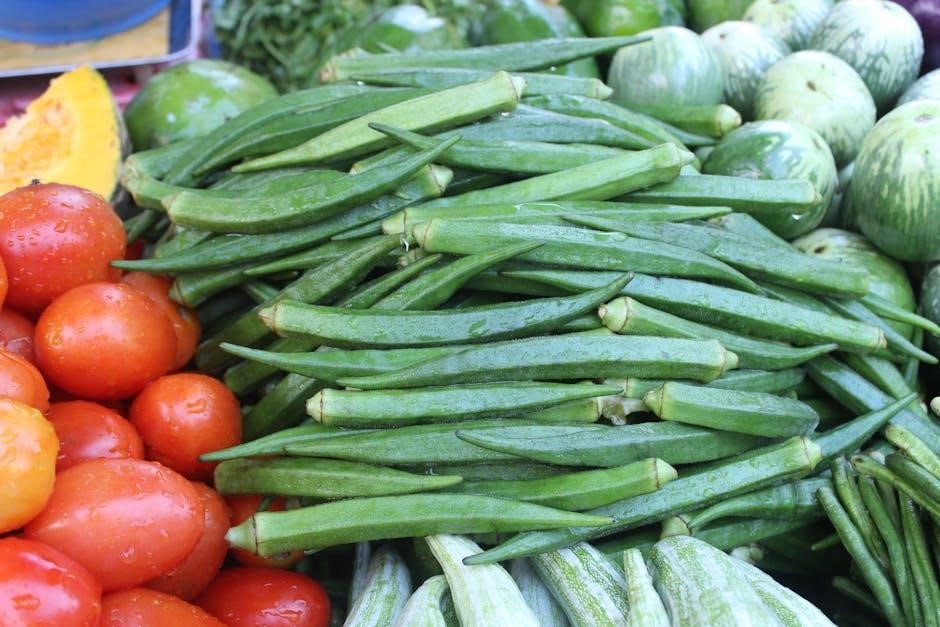The Specific Carbohydrate Diet (SCD) is a dietary approach designed to manage conditions like IBD and IBS by restricting certain carbohydrates․

What is the SCD?
The Specific Carbohydrate Diet (SCD) is a dietary approach designed to manage digestive disorders such as inflammatory bowel disease (IBD) and irritable bowel syndrome (IBS)․ It focuses on eliminating carbohydrates that are difficult for the body to digest, which can contribute to inflammation and discomfort․ The diet emphasizes legal foods, which are easily digestible, and avoids illegal foods, such as grains, legumes, and most starchy vegetables․ By restricting these problematic carbs, the SCD aims to promote gut healing, reduce inflammation, and alleviate symptoms associated with these conditions․ The diet is tailored to individuals, as responses to certain foods can vary, making it a personalized approach to improving digestive health and overall well-being․ The SCD has gained popularity for its potential to manage chronic digestive issues effectively․
Benefits of the SCD
The Specific Carbohydrate Diet (SCD) offers numerous benefits, particularly for individuals managing digestive disorders like IBD and IBS․ By eliminating hard-to-digest carbohydrates, the diet reduces inflammation and promotes gut healing․ Many people experience improved digestion, reduced symptoms like bloating and abdominal pain, and enhanced overall well-being․ The SCD can also help restore a balanced gut microbiome, which is crucial for immune function and nutrient absorption․ Additionally, the diet encourages the consumption of nutrient-dense, whole foods, which provide essential vitamins and minerals․ Over time, many individuals report increased energy levels and a reduction in chronic symptoms, making the SCD a valuable tool for long-term digestive health management․ The diet’s structured approach also helps individuals identify and avoid problematic foods, leading to a more personalized and effective eating plan․

Understanding the SCD Food List
The SCD food list categorizes foods as legal, illegal, or grey area, providing clear guidance on what to eat and avoid for optimal digestive health․
It helps users make informed choices, ensuring they stick to foods that promote healing and avoid those that may trigger digestive issues or inflammation․
Overview of Legal Foods
Legal foods on the SCD are those that are easily digestible and do not contain disaccharides or polysaccharides, which can exacerbate digestive issues․
These include meats (grass-fed, pasture-raised), fish, eggs, and certain fruits and vegetables that are low in fiber and sugars, promoting healing and minimizing inflammation․
Healthy fats like olive oil, coconut oil, and avocado are also permitted, along with natural sweeteners like honey and fruit juice (in moderation)․

Legal foods are carefully selected to avoid triggering digestive discomfort, making them a cornerstone of the SCD for those managing chronic conditions like IBS or IBD․
They provide essential nutrients while supporting the body’s natural healing processes, ensuring a balanced and sustainable diet․
Overview of Illegal Foods
Illegal foods on the SCD include grains, legumes, starches, and most dairy products, as they contain disaccharides or polysaccharides that can trigger inflammation․
Processed foods, high-sugar fruits, starchy vegetables, and certain high-fructose foods are also prohibited, as they can disrupt digestion and worsen symptoms․
Alcohol, corn, soy, and foods containing gluten are strictly avoided, as they are difficult to digest and may impede healing․
Illegal foods are those that can cause inflammation, hinder gut healing, or exacerbate conditions like IBS or IBD, making them a critical category to avoid on the SCD․
Understanding and eliminating these foods is essential for achieving the diet’s therapeutic benefits and managing chronic digestive issues effectively․

Grey Area Foods Explained
Grey area foods on the SCD are items that may be allowed conditionally or require special preparation to comply with the diet’s rules․
Examples include certain types of fermented foods, like some cheeses or soy products, which are tolerated by some but not all․
Other grey areas involve foods like chocolate, which must be sugar-free and dairy-free to be considered legal․
Some processed foods, such as gluten-free alternatives, may be acceptable if made from legal ingredients․
Grey area foods often depend on individual tolerance, and their inclusion should be approached cautiously, ideally after establishing a baseline of health․
Consulting the SCD community or a healthcare provider can help clarify whether these foods are suitable for your specific situation․

Categories of Foods on the SCD
The SCD organizes foods into categories like meats, poultry, fish, seafood, eggs, dairy, fruits, vegetables, and fats/oils, each with specific guidelines for legality․
Meat and Poultry
The SCD permits a wide variety of meats and poultry, including beef, chicken, turkey, and pork․ These must be fresh and free from additives or preservatives․ Grass-fed and lean cuts are recommended to minimize fat intake․ Organ meats like liver are also allowed but should be consumed in moderation․ Processed meats, such as sausages and deli meats, are typically prohibited due to added sugars, preservatives, and fillers․ Proper cooking methods, like grilling, baking, or roasting, are encouraged to maintain nutritional value․ It’s essential to choose high-quality sources to ensure compliance with SCD guidelines and avoid potential irritants․ Always refer to the SCD food list PDF for specific details on allowable meats and poultry․
Fish and Seafood
Fish and seafood are excellent protein sources on the SCD, offering essential nutrients like omega-3 fatty acids․ Wild-caught fish such as salmon, cod, and trout are recommended for their lower mercury content․ Shellfish like shrimp, scallops, and mussels are also permitted, provided they are free from additives․ Avoid breaded or processed seafood products, as they often contain illegal ingredients like gluten or added sugars․ Freshness is key, so opt for sustainably sourced options․ Canned varieties, if used, must be in water or natural oils without added preservatives․ Always check the SCD food list PDF for specific guidance, as some types of seafood may be restricted based on preparation or ingredients․ Incorporating fish and seafood can enhance meal variety and nutritional balance on the SCD․
Eggs and Dairy
Eggs are a versatile and nutritious option on the SCD, providing high-quality protein and essential nutrients․ They can be prepared in various ways, such as boiled, scrambled, or fried, making them a convenient addition to meals․ Dairy products are also permitted but must be carefully selected․ Plain, full-fat yogurt without added sugars or thickeners is a great choice, as it supports gut health․ Hard cheeses like cheddar and Parmesan are allowed, while soft cheeses may require caution due to potential mold content․ Homemade dairy products are often recommended to ensure compliance with SCD guidelines․ Always refer to the SCD food list PDF for specific dairy options, as some may contain illegal ingredients․ Eggs and dairy can add variety and richness to the diet when chosen mindfully․
Fruits
Fruits are a delicious and nutritious part of the SCD, offering natural sweetness and essential vitamins․ Legal fruits include bananas, apples, berries, citrus fruits, and stone fruits like peaches and nectarines․ Tropical fruits like mangoes and pineapples are also permitted but should be consumed in moderation due to their higher sugar content․ Avoid fruits with added sugars, juices, or dried versions, as they can contain illegal ingredients․ Fresh, ripe fruits are ideal, as unripe varieties may cause digestive discomfort․ When following the SCD, it’s important to monitor portion sizes and pair fruits with protein or fats to balance blood sugar levels․ Always consult the SCD food list PDF for specific guidance on fruit choices to ensure compliance with the diet’s guidelines․
Vegetables
Vegetables play a vital role in the SCD, providing essential nutrients and fiber while adhering to the diet’s restrictions․ Legal vegetables include leafy greens like spinach, kale, and lettuce, as well as cucumbers, bell peppers, and zucchini․ Root vegetables such as carrots, beets, and radishes are also permitted․ However, starchy vegetables like potatoes, corn, and winter squash are not allowed due to their high carbohydrate content․ Fresh vegetables should be consumed raw or cooked, avoiding any added sugars or illegal ingredients․ It’s important to introduce vegetables gradually, especially for those with sensitive digestion, to avoid discomfort․ Always refer to the SCD food list PDF for a comprehensive guide to ensure compliance and make informed choices about vegetable selection and preparation․
Fats and Oils
Fats and oils are crucial for maintaining energy and overall health on the SCD․ Legal options include avocado oil, olive oil, coconut oil, and ghee, which are free from harmful additives․ Fats like lard and tallow from grass-fed animals are also permitted․ However, avoid processed oils such as canola, soybean, and vegetable oils, as they contain unhealthy fats and may be contaminated with illegal ingredients․ Additionally, trans fats and hydrogenated oils should be strictly avoided․ When using fats and oils, ensure they are cold-pressed and unrefined to preserve their nutritional benefits․ Always consult the SCD food list PDF for a detailed breakdown of allowed fats and oils to make informed choices that align with the diet’s guidelines and support digestive health․

Benefits of Using an SCD Food List PDF
An SCD food list PDF provides clarity and convenience, helping adherents easily identify legal and illegal foods, reducing confusion and ensuring dietary compliance for better health outcomes․
Convenience and Portability
An SCD food list PDF offers unparalleled convenience, allowing users to access dietary guidelines anytime, anywhere․ Its portable format ensures that whether you’re grocery shopping, dining out, or meal planning, the information is always at your fingertips․ The PDF can be easily downloaded and stored on mobile devices, making it a constant companion for those navigating the Specific Carbohydrate Diet․ Additionally, the digital format enables quick searches and easy navigation, helping users identify legal and illegal foods without delay․ This convenience is especially valuable for individuals transitioning to the SCD, as it reduces confusion and ensures adherence to the diet’s principles․ The portability of the PDF also makes it a practical tool for sharing with family, friends, or healthcare providers, fostering a supportive environment for dietary success․
Comprehensive Guide
A comprehensive guide is essential for navigating the complexities of the Specific Carbohydrate Diet (SCD)․ The SCD food list PDF serves as an invaluable resource, detailing legal and illegal foods, grey areas, and category-specific guidelines․ It provides clear, organized information to help users make informed dietary choices․ This guide is particularly useful for individuals new to the SCD, offering a roadmap to understanding which foods are permissible and why․ By adhering to the comprehensive guide, individuals can better manage their health conditions and achieve their dietary goals․ The detailed structure ensures that users are well-informed, reducing confusion and promoting long-term adherence to the diet․ Additionally, the guide supports personalized meal planning and helps users avoid common pitfalls, making it an indispensable tool for SCD success․
Easy to Share
The SCD food list PDF is designed to be easily shared with family, friends, or healthcare providers, ensuring everyone involved in your diet is on the same page․ Its digital format allows for quick distribution via email or messaging apps, making it simple to access and reference․ Whether you’re coordinating with a caregiver or sharing with a support group, the PDF’s portability ensures that vital dietary information is always within reach․ This ease of sharing fosters a supportive environment, helping you stay accountable and informed as you navigate the SCD․ The ability to print or save the list across multiple devices further enhances its accessibility, making it a practical tool for daily use and long-term success on the diet․

Implementing the SCD
Implementing the SCD involves a structured approach to eliminating harmful carbohydrates and focusing on nutrient-dense foods, guided by the SCD food list PDF for clarity and compliance․
How to Transition to the SCD
Transitioning to the SCD requires careful planning and gradual changes to avoid digestive upset․ Start by eliminating illegal foods and incorporating legal options from the SCD food list PDF․ Focus on introducing new foods one at a time to monitor tolerance․ Keeping a food diary can help track progress and identify potential triggers․ It’s essential to stock your pantry with SCD-compliant ingredients and plan meals in advance to ensure adherence․ Consulting with a healthcare provider or dietitian can also provide personalized guidance and support during the transition phase․ A slow and methodical approach will help your body adjust smoothly to the new dietary regimen․
Meal Planning Tips
Effective meal planning is crucial for success on the SCD․ Start by referencing the SCD food list PDF to ensure all ingredients are compliant․ Plan meals for the week, including breakfast, lunch, dinner, and snacks, to avoid last-minute decisions that may lead to non-compliant choices․ Consider batch cooking to save time and reduce stress․ Keep a well-stocked pantry with legal foods to make meal preparation easier․ Use the SCD food list PDF to explore new recipes and avoid repetition․ Additionally, prep meals in advance to accommodate busy schedules․ Finally, keep a food diary to track what works and what doesn’t, helping you refine your meal plans over time․ This structured approach ensures adherence and makes the diet sustainable long-term․
Common Mistakes to Avoid
When following the SCD, several common mistakes can hinder progress․ One major error is assuming all gluten-free products are SCD-compliant, which isn’t true․ Always cross-reference with the SCD food list PDF․ Another mistake is introducing illegal foods too early, which can trigger setbacks․ Overlooking the importance of proper food preparation, such as soaking and cooking beans thoroughly, can also be problematic․ Additionally, neglecting to read food labels can lead to unintentional consumption of illegal ingredients․ Finally, rushing the reintroduction of foods after the initial phase can disrupt healing․ Being vigilant and strictly adhering to the SCD guidelines is essential for optimal results and minimizing potential pitfalls․

Frequently Asked Questions About the SCD
Common questions include whether grains or legumes are allowed, how soon results can be expected, and clarification on grey-area foods, all addressed in the SCD food list PDF․
Can I Eat Grains on the SCD?
Grains are generally prohibited on the Specific Carbohydrate Diet due to their complex carbohydrate structure, which can be difficult to digest and may exacerbate symptoms․
Are Legumes Allowed?
Legumes, such as beans, lentils, and peanuts, are not allowed on the Specific Carbohydrate Diet (SCD)․ This is because they contain complex sugars like raffinose, which the body struggles to fully digest․ Undigested sugars can ferment in the gut, potentially causing bloating, gas, and discomfort, particularly for individuals with digestive disorders․ The SCD aims to eliminate foods that may irritate the gut lining or disrupt digestive balance, making legumes restricted․ However, some individuals may tolerate small amounts of certain legumes after achieving significant healing, but this should be approached cautiously and under guidance․
How Long Until I See Results?
The time it takes to see results on the Specific Carbohydrate Diet (SCD) varies depending on individual factors and the severity of symptoms․ Some people may experience improvements within a few days, while others may take several weeks or months․ Initial benefits often include reduced bloating and digestive discomfort․ More significant changes, like healing of the gut lining and resolution of chronic symptoms, can take longer․ Consistency with the diet is key, as deviations can slow progress․ It’s important to monitor symptoms and adjust the diet as needed, potentially with the guidance of a healthcare provider, to achieve optimal results․

Resources for the SCD
The SCD offers a variety of resources, including food lists, guides, and books, to help individuals implement and understand the diet effectively for better health outcomes․
Where to Find the SCD Food List PDF
The SCD food list PDF can be found on the official SCD Foundation website, as well as through reputable health and nutrition websites․ Many resources offer downloadable guides that outline legal and illegal foods, helping individuals follow the diet accurately․ Additionally, some eBooks and digital downloads on platforms like Amazon provide comprehensive SCD food lists․ Support groups and forums often share these resources, ensuring accessibility for those adopting the diet․ Always verify the source to ensure the information is up-to-date and aligned with the latest SCD guidelines for safe and effective implementation․
Additional Tools and Guides
Beyond the SCD food list PDF, several tools and guides are available to support individuals on the diet․ Meal planning templates and grocery lists can help organize shopping and cooking․ Mobile apps like SCD Meal Planner offer recipe ideas and tracking features to stay compliant․ Additionally, cookbooks specifically designed for the SCD provide creative and delicious meal options․ Online communities and forums share practical tips and experiences, fostering a supportive environment for those navigating the diet․ For those with specific needs, such as holidays or travel, specialized guides are available to ensure adherence to the SCD while enjoying meals․ These resources collectively enhance the ease and sustainability of following the diet, making it more accessible for everyone․
Recommended Books
Several books are highly recommended for those following the Specific Carbohydrate Diet (SCD)․ “Breaking the Vicious Cycle” by Elaine Gottschall is a foundational guide, detailing the science and practical implementation of the diet․ “The SCD Lifestyle Book” by Steven Wright and Jordan Reasoner offers a modern, user-friendly approach with meal plans and tips․ “The Gut and Psychology Syndrome” by Dr․ Natasha Campbell-McBride provides insights into the gut-brain connection and dietary healing․ These books, along with cookbooks like “The SCD Cookbook” by Katie Chalmers, offer a wealth of knowledge and recipes to support a successful SCD journey․ They are invaluable resources for understanding the diet, preparing meals, and achieving long-term health benefits․

Leave a Reply